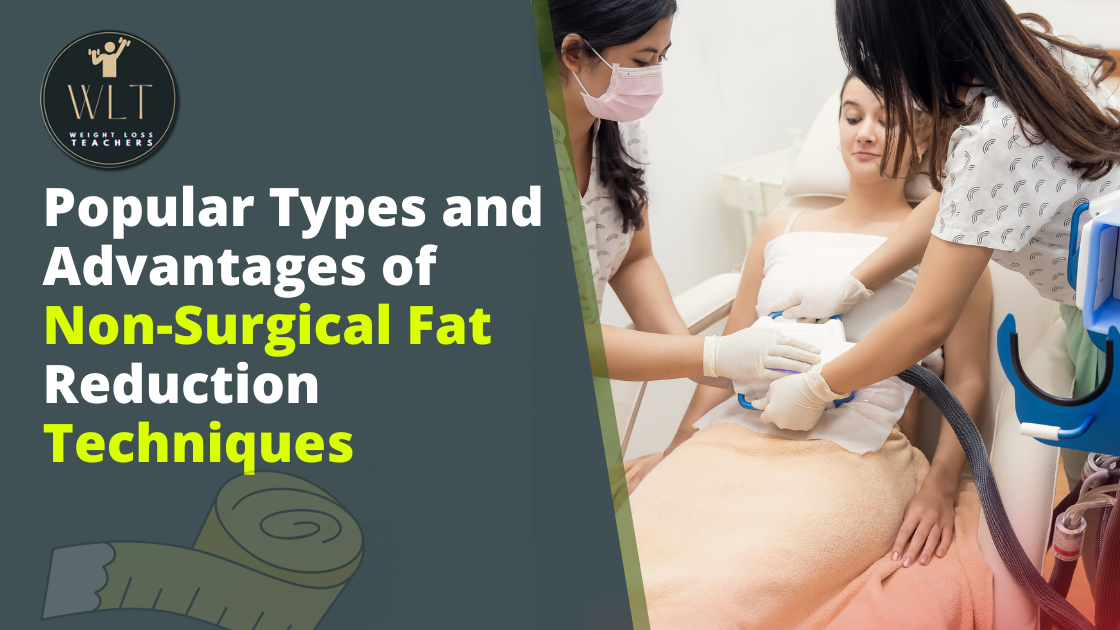
Popular Types and Advantages of Non-Surgical Fat Reduction Techniques

Excess fat can be a persistent problem for many people, regardless of their age or gender. For years, surgical techniques like liposuction were the sole choice for fat reduction, but today, non-surgical alternatives have become increasingly popular.
Table of Contents
Introduction
Non-surgical fat reduction techniques can be a fantastic alternative for people who do not want to undergo surgery, have hectic schedules, or cannot afford the downtime required following surgical operations. In this post, we will discuss the many non-surgical fat removal techniques available and their effectiveness.
What is Non-Surgical Fat Reduction?
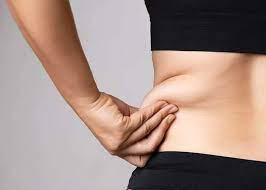
Non-surgical fat reduction refers to the use of different procedures to eliminate or reduce fat deposits in the body without undergoing surgery. These treatments mainly involve the use of energy-based instruments such as lasers, radiofrequency, ultrasound, and freezing technologies to break down and destroy fat cells. The body then naturally removes the dead fat cells over time.
Unlike surgical procedures, non-surgical fat removal techniques do not require general anesthesia, incisions, or substantial recovery time. Patients can frequently return to their routine activities immediately or shortly after therapy.
Types of Non-Surgical Fat Reduction Techniques
The major types of non-surgical fat removal techniques are listed below.
- Cryolipolysis (CoolSculpting)

Cryolipolysis, a pioneering non-surgical fat removal treatment popularly known as CoolSculpting, has changed the world of body shaping. This revolutionary technology leverages the power of controlled cooling to target and destroy recalcitrant fat cells, giving patients a safer and less invasive alternative to traditional surgical methods. Let’s look at the science underlying this procedure and how it produces such amazing outcomes.
The principle that fat cells are more susceptible to cold temperatures than surrounding tissues is at the heart of Cryolipolysis. The treatment starts with precisely applying a cooling device to the targeted location. The temperature is gradually reduced to the point where fat cells crystallize, while the overlying skin and surrounding tissues are not affected. This regulated cooling causes apoptosis, a natural biological response that causes planned cell death in the targeted fat cells.
Apoptosis, also known as cellular self-destruction, is an important process that the body uses to eliminate damaged or superfluous cells. Fat cells that go through apoptosis become dormant and are progressively degraded by the body’s immune system. Following treatment, the injured fat cells are broken down and removed naturally by physiological processes, resulting in a steady reduction in fat volume in the treated area.
Cryolipolysis’s progressive nature is critical to creating natural-looking effects. Unlike surgical procedures, which might result in abrupt alterations, the body’s slow clearance of fat cells using Cryolipolysis ensures that the transformation proceeds in accordance with the body’s own processes. This feature is especially appealing to patients looking for a gentler, more gradual enhancement of their physique.
Cryolipolysis has various advantages in addition to fat loss. Because the process is non-invasive, no surgical incisions or anesthesia are required, reducing the related risks and downtime. Patients can often resume their normal activities immediately following treatment, making it a practical option for those who lead hectic lives.
It is crucial to highlight that, while cryolipolysis can effectively reduce fat, it is not a substitute for a healthy lifestyle. Long-term success is dependent on eating a well-balanced diet and engaging in frequent physical activity. Individual responses to Cryolipolysis may also vary, and repeated treatments may be required to achieve optimal outcomes. Consultation with a skilled medical practitioner is required to establish whether Cryolipolysis is the best option for you and to build a customized treatment plan based on your specific goals and needs.
- Radiofrequency (RF) Technology
In the field of non-surgical fat reduction and skin tightening, radiofrequency (RF) technology has emerged as a versatile and successful instrument. This novel method targets adipose tissue with regulated radiofrequency radiation, stimulating collagen synthesis, tissue tightening, and fat cell destruction. Let’s look at the physics underlying RF technology and how it might help people obtain their desired body shapes.
The notion of a regulated energy supply underpins RF technology. When the RF device is applied to the targeted location, electromagnetic waves penetrate the skin and cause heat within the adipose tissue. This controlled heat has two effects: it stimulates collagen formation while also damaging fat cell membranes.

Collagen, a protein present in the skin and connective tissues, is essential for skin suppleness and firmness. Collagen production naturally declines with age, resulting in sagging and laxity. The use of RF energy stimulates fibroblasts, the cells in charge of collagen synthesis, resulting in an increase in collagen production. As a result, the skin becomes firmer and tighter over time. The skin-tightening benefits of RF technology are especially advantageous when combined with fat reduction since they help prevent sagging and ensure a smoother overall appearance.
Furthermore, RF technology’s controlled heat has a direct effect on fat cells. The rise in temperature compromises the integrity of fat cell membranes, forcing them to release their stored contents, which are mostly fatty acids. These fatty acids are digested by the body’s natural processes once they are released, resulting in a reduction in fat volume. RF technology is a potent tool for both body contouring and skin rejuvenation due to its combination of collagen stimulation and fat cell breakdown.
RF treatments are frequently adjustable, allowing practitioners to tailor energy levels to suit patient needs and therapeutic goals. Furthermore, because RF technology is non-invasive, no incisions, anesthesia, or substantial downtime are required. Patients can usually continue their normal activities immediately following the operation, making RF treatments an appealing alternative for individuals looking for convenience as well as effective outcomes.
RF technology, like any medical technique, has limitations and constraints. While some patients may see immediate benefits, a series of sessions is usually advised to attain the best outcomes. Individual responses to RF treatments may differ, so it is critical to contact a skilled medical expert to establish qualification and develop a specific treatment strategy.
- High-Intensity Focused Ultrasound (HIFU)
HIFU is a cutting-edge non-surgical fat reduction treatment that uses focused ultrasound energy to target and eliminate fat cells beneath the skin’s surface. This cutting-edge technique provides precise and regulated fat reduction, making it a popular choice for people who want to sculpt their bodies without enduring invasive surgical treatments. Let’s look at the mechanics of HIFU and see how it produces such amazing outcomes.
The HIFU principle is based on the controlled delivery of focused ultrasound waves. When these waves focus on a specific target location, thermal coagulation sites form inside the underlying adipose tissue. This heat effect ruptures the fat cell membranes, resulting in adipocytolysis. Fat cells are destabilized and broken down during adipocytolysis, releasing their stored contents into the surrounding tissue.

When fat cells are disrupted, the body’s natural processes kick in. Macrophages, a type of white blood cell that cleans up cellular debris, engulf and remove the injured fat cell. The body’s lymphatic system processes and eliminates these leftovers over several weeks, resulting in an apparent reduction in fat thickness and volume in the treated area.
Precision is one of the most significant advantages of HIFU. The method enables precision targeting of certain locations while preserving surrounding tissues and structures. Because of its precision, HIFU is an ideal choice for contouring sensitive or difficult-to-reach parts of the body.
Aside from fat loss, HIFU therapies have various other advantages. The process stimulates collagen formation in the skin, which results in increased skin elasticity and firmness. The combination of fat reduction and skin tightening offers patients a comprehensive approach to reaching their desired body features.
There are precautions and potential restrictions to be aware of, as with any medical procedure. Individual responses to HIFU treatments may differ, and repeated sessions may be required to attain the best outcomes. A full consultation with a certified medical practitioner is required to establish appropriateness and develop a specific treatment plan.
The non-invasive nature of HIFU treatments appeals to people who want to avoid surgery and its associated risks and inconveniences. Patients can usually resume their normal activities right away, making HIFU a suitable option for people with hectic schedules.
- Low-Level Laser Treatment (LLLT)
LLLT, also known as cold laser treatment, has emerged as a unique and non-invasive technique for activating fat cells and promoting their disintegration. This novel method targets adipose tissue with low-level lasers or light-emitting diodes (LEDs), stimulating the release of fatty acids that are then processed by the body. Let’s look at the mechanics of LLLT and how it helps with non-surgical fat reduction.
LLLT works on the premise that different wavelengths of light have different effects on cells and tissues. Light energy enters the adipose tissue and interacts with the fat cells when low-level laser or LED devices are applied to the skin. This contact activates fat cells, causing microscopic pores or openings in their membranes to form.
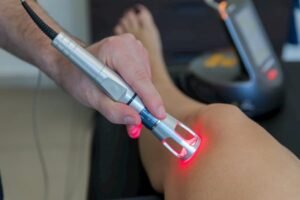
The creation of these holes has a substantial impact on fat cells. It causes the release of fatty acids from within the cells into the interstitial fluid, which surrounds the cells. These fatty acids are carried through the bloodstream to tissues, where they can be digested and utilized for energy production once they are released.
These fatty acids are eventually broken down and consumed by the body’s normal metabolic processes. Over time, this results in a reduction in fat volume in the treated area. Because of its gentle and non-invasive nature, LLLT is an enticing alternative for anyone looking for a more moderate approach to fat removal and body reshaping.
Patients often handle LLLT treatments well and experience little discomfort. Patients may feel minor tingling or heat during the process, but these symptoms are usually transient and disappear after the treatment session.
One of the benefits of LLLT is the possibility of synergistic effects. LLLT has been shown to improve skin health and attractiveness by increasing blood flow and stimulating collagen formation, in addition to its effect on fat cells. LLLT is a versatile alternative for people seeking comprehensive body contouring solutions due to its dual benefits of fat reduction and possibly skin renewal.
It is crucial to remember that, while LLLT can be beneficial, individual reactions may differ. Multiple therapy sessions are usually advised to attain the best results. Consultation with a skilled medical practitioner is essential for determining whether LLLT is the best option and developing a customized treatment plan based on individual goals and needs.
- Injection Lipolysis
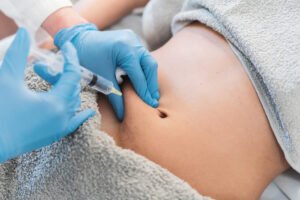
Also known as “fat-dissolving injections,” injection lipolysis has gained popularity as a non-surgical fat removal technique that provides a localized and focused approach to reshaping specific parts of the body. This novel treatment includes injecting a specific solution into the desired area to break down fat cells. Let us delve into the complexities of Injection Lipolysis and see how it delivers such astounding outcomes.
The basic idea underlying Injection Lipolysis is to employ a specially designed solution containing deoxycholic acid. Deoxycholic acid is a naturally occurring bile acid that aids in the digestion of dietary fat. Deoxycholic acid, when injected into the body, works as a powerful fat-cell dissolving agent, efficiently breaking down the structure of fat cells.
Typically, the process is carried out in a medical facility, with a qualified practitioner accurately injecting the solution into the targeted location. Deoxycholic acid, when administered, destroys the integrity of fat cell membranes, causing stored fat to be released. The body’s natural mechanisms gradually metabolize and digest the released fat, resulting in a reduction in fat volume and a more contoured appearance.
Injection Lipolysis is frequently used to treat tiny pockets of fat on the chin and abdomen. The operation is rather brief, and the majority of patients tolerate it well. Typically, discomfort during treatment is negligible, and any slight side effects fade quickly after the surgery.
Precision is one of the advantages of Injection Lipolysis. Practitioners can adjust the treatment to precisely target certain locations while leaving adjacent tissues undisturbed. This precision makes Injection Lipolysis particularly appealing for people looking for targeted fat loss in specific areas.
Injection Lipolysis results may take some time to become fully noticeable. Patients can anticipate progressive changes in the treated area over several weeks or months. Depending on individual goals and the quantity of fat reduction desired, many treatment sessions may be required to get the best results.
While Injection Lipolysis is a non-surgical fat reduction option, it is vital to note that maintaining a healthy lifestyle is still essential for long-term results. Adhering to a healthy diet and engaging in regular physical activity can help ensure that the results last.
- Mesotherapy
Mesotherapy, a new non-surgical fat removal method, has gained popularity for its novel approach to body shaping. In this treatment, a tailored solution including vitamins, minerals, enzymes, and other bioactive components is injected into the targeted location. Let’s delve into the complexities of Mesotherapy and see how it leads to effective fat loss.
Mesotherapy is based on the idea of delivering a customized blend of nutrients straight into the adipose tissue. Phosphatidylcholine, a chemical that can break down fat cells, is frequently included in the solution. When injected into the body, phosphatidylcholine functions as a strong agent to target and damage fat cell membranes, thus commencing the fat breakdown process.
The procedure begins with a consultation with a certified medical practitioner who evaluates the patient’s goals and creates a personalized solution. The fluid is skillfully injected into the targeted area using small needles during the therapy session. The bioactive components of the solution work together to break down fat cells while improving blood circulation and lymphatic drainage in the treated area.

Mesotherapy is ideal for reducing localized fat deposits on the chin and abdomen. The technique is noted for causing little discomfort, and patients may usually resume their normal activities soon following the session. The broken-down fat is gradually digested by the body and removed through natural processes over time, resulting in a reduction in fat volume and improved body contour.
Mesotherapy results are not immediate and require patience. The full effects may not be obvious for many weeks while the body processes the liberated fat and the skin tightens. Because fat loss is a progressive process, numerous therapy sessions are frequently necessary to get the desired result.
The comprehensive approach of mesotherapy goes beyond fat loss. Infusing vitamins, minerals, and other therapeutic substances into the treated region nourishes it, helping to improve skin health and appearance. Increased blood flow and lymphatic circulation aid in the elimination of waste materials, boosting tissue vitality overall.
Before receiving Mesotherapy, as with any medical operation, it is critical to have a full consultation with a trained practitioner. This guarantees that the treatment is tailored to the patient’s specific goals and needs. Furthermore, maintaining a healthy lifestyle through adequate nutrition and frequent exercise is critical for enhancing and preserving the outcomes of Mesotherapy.
Note: There might be affiliate links mentioned here. We may receive a commission if you purchase a product through an affiliate link. There is no additional charge for you. Please do your own research before making any online purchases.
Advantages of Non-Surgical Fat Removal Techniques
Non-surgical fat reduction techniques have grown in popularity due to their numerous benefits, providing consumers with a safe and effective approach to obtaining their ideal body shapes without requiring surgical intervention. Let’s have a look at the benefits of non-surgical fat reduction methods, emphasizing their minimally invasive nature, lower chance of problems, personalized treatments, gradual outcomes, and minimal downtime.

- Paradigm Shift in the Minimally Invasive Approach
One of the most appealing elements of non-surgical fat reduction techniques is that they are either slightly invasive or non-invasive. Liposuction, for example, is a traditional surgical technique that frequently involves incisions, anesthesia, and a lengthy recuperation period. Non-surgical treatments, on the other hand, avoid these intrusive features, allowing patients to benefit from fat reduction without the need for surgical intervention. This paradigm shift eliminates not just physical stress on the body but also related suffering, resulting in a more comfortable experience for patients.
- Risk and Complication Mitigation
When compared to surgical fat reduction treatments, non-surgical fat reduction methods have a significantly lower risk of problems. Surgical procedures inherently include the risk of infection, scarring, and anesthesia-related complications. Non-surgical procedures, on the other hand, eliminate most of these problems. Patients who have underlying health concerns that make surgery a riskier option can benefit from a safer approach to body contouring by avoiding surgical incisions and anesthesia.
- Personalization for Better Results
The tremendous flexibility and customizability of non-surgical fat reduction procedures is one of their great benefits. Because each person’s body is unique, practitioners can modify these non-invasive approaches to address specific issues. Energy levels, treatment time, and applicator sizes may all be customized to precisely target different parts of the body and accommodate varying degrees of fat deposition. This individualized approach ensures that treatments are tailored to the patients’ aesthetic goals and body features.
- The Beauty of Gradual, Natural-Appearing Results
Non-surgical fat reduction treatments provide a step-by-step approach to reaching desired results, fostering natural-looking results that blend in with a patient’s overall appearance. This progressive decrease in fat volume helps the skin to acclimate and adapt over time, avoiding the rapid and sometimes jarring changes associated with surgical procedures. Patients can accept their changing appearance as their bodies adapt to treatment, boosting confidence and contentment.
- Minimal Downtime: A Priceless Resource
Time is a valuable commodity in our fast-paced world. Non-surgical fat removal techniques require little downtime, allowing patients to quickly resume their normal activities following the surgery. Non-surgical treatments, as opposed to the lengthy recuperation periods that are commonly required following surgery, allow individuals to resume work, exercise, and social engagements without major interruption. This simplicity is especially beneficial for people with hectic schedules or demanding lifestyles, as it allows for the smooth integration of body contouring into their routines.
Considerations for Non-Surgical Fat Reduction
Before going on a non-surgical fat reduction path, it’s critical to be well-informed and examine a variety of aspects. Non-surgical body sculpting treatments are appealing, but understanding the intricacies and being prepared for specific concerns is critical. Let’s get into it, starting with having realistic expectations, then moving on to appropriate candidate selection, the necessity for several sessions, the transient nature of results, and the feelings that may develop during treatment.
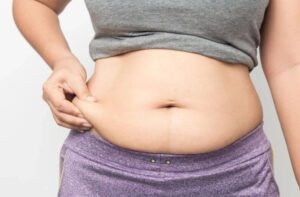
- Realistic Expectations: Laying the Groundwork
The allure of non-surgical fat reduction stems from its ability to shape the body and improve one’s appearance. Individuals must, however, set realistic expectations from the start. While these strategies can provide obvious results, it’s important to remember that the transformation may take time and patience. Understanding that numerous treatment sessions may be required for optimal results is critical to approaching the procedure with a positive attitude.
- Candidate Selection: The Suitability Art
The path to non-surgical fat reduction begins with the right candidate. Individuals who are close to their target body weight but suffer from localized fat deposits that are resistant to diet and exercise are typical candidates. It is critical to consult with a skilled practitioner to determine one’s eligibility for the chosen technique. A thorough review ensures that the individual’s goals are aligned with the procedure’s prospective consequences.
- Several Sessions: A Path to Perfection
Non-surgical fat removal techniques frequently take a step-by-step approach. While some benefits may be seen right away, it’s crucial to remember that most approaches take a number of sessions to produce the best effects. These sessions are usually scheduled several weeks apart to give the body time to respond and adapt to the treatment. Accepting this path of incremental growth is critical to receiving the benefits of a sculpted physique.
- Short-Term Results: Accepting Maintenance
The lifetime of non-surgical fat reduction treatments varies depending on individual circumstances, lifestyle, and the method used. While these treatments can provide spectacular results, it’s crucial to remember that the effects are just temporary. Maintenance sessions may be advised to maintain the effects over time. Adopting a proactive approach to retaining the results can assist people in continuing to benefit from their chosen operation.
- Treatment Sensation: Getting the Most Out of the Experience
Patients may experience tingling, heat, or slight discomfort during non-surgical fat removal treatments. It’s crucial to emphasize that these sensations are usually brief and tolerable. The body’s reaction to the treatment indicates that the process has begun. Any discomfort usually goes away after the operation, leaving patients with a sense of accomplishment and eagerness for the gradual metamorphosis that will occur.
Popular Non-Surgical Fat Reduction Technologies
Non-surgical fat reduction is brimming with cutting-edge technologies that allow people to sculpt their bodies without invasive procedures. CoolSculpting, SculpSure, UltraShape, and Vanquish are popular options among these technologies, each employing unique methods to achieve excellent fat removal results.
- CoolSculpting: The Precision Chill

CoolSculpting, widely considered a pioneer in non-surgical fat reduction, maintains a leading position in the area. Controlled cooling technology, which targets specific locations by freezing and crystallizing fat cells, is at its heart. Controlled cooling, also known as cryolipolysis, causes apoptosis, or natural cell death. CoolSculpting is especially successful for removing stubborn fat deposits from the abdomen, flanks, thighs, and even the chin. The procedure’s precision and adaptability make it a popular alternative for people looking for localized fat reduction.
- SculpSure: Laser-Assisted Transformation
SculpSure has received praise for its use of laser radiation to heat and disrupt fat cells. This non-invasive approach targets fat cells beneath the skin’s surface, causing them to break down gradually. The laser applicators are applied to the desired location, where the energy penetrates and elevates the temperature of the fat cells. The treated fat cells are metabolized and eliminated by the body’s natural processes over time. SculpSure is frequently used to reduce fat in areas such as the abdomen and love handles, making it a valuable tool for achieving a more contoured physique.
- Pulsed Precision UltraShape

UltraShape distinguishes itself through its novel application of pulsed ultrasound energy. This technology targets and destroys fat cells selectively while leaving surrounding tissues unharmed. The pulsed ultrasound waves disrupt the integrity of fat cell membranes, triggering a fat breakdown process. UltraShape is frequently used to reduce fat in areas such as the abdomen, thighs, and flanks. Its non-invasive nature and precise targeting make it a popular choice among those looking for effective body sculpting.
- Vanquish: Radiofrequency’s Power
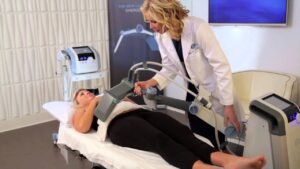
Vanquish is a non-surgical fat reduction device that uses radiofrequency energy. This method of contactless treatment delivers concentrated radiofrequency energy to large treatment areas, such as the entire abdomen. The radiofrequency energy heats the fat cells, causing them to die over time. Vanquish’s unique method makes it an efficient alternative for people who want to address greater regions without coming into direct contact with their skin. Its ability to cover large areas distinguishes it as a valuable tool in the arsenal of non-surgical fat reduction techniques.
Navigating the Path to Transformation: Safety and Side Effects
The safety of non-surgical fat removal techniques is a critical issue for anyone considering these novel options. These operations are typically regarded as safe when performed by trained and experienced medical personnel. Temporary redness, swelling, bruising, and minor discomfort at the treatment site are all common adverse effects. These side effects are often transient, fading within days or weeks of the treatment.
Following post-treatment recommendations, staying hydrated, and living a healthy lifestyle can all help in the recovery process. To ensure both safety and optimal results, these therapies must be performed under the supervision of qualified practitioners.
FAQs
What is non-surgical fat reduction?
Non-surgical fat reduction refers to the employment of numerous strategies to eliminate or reduce fat deposits in the body without the necessity for surgical operations. These procedures involve energy-based gadgets, injections, or specific solutions to break down and destroy fat cells.
How do non-surgical fat reduction procedures work?
Non-surgical fat reduction procedures use numerous mechanisms, such as controlled cooling, radiofrequency energy, ultrasound, or specialized solutions, to target and break down fat cells. The body then naturally removes the damaged fat cells over time.
What are the advantages of non-surgical fat reduction over surgery?
Non-surgical fat reduction techniques provide various advantages, including minimum invasiveness, lower risk of problems, personalized treatments, progressive and natural-looking results, and minimal downtime compared to surgical procedures.
Is it painful to undergo non-surgical fat reduction treatments?
Patients often handle non-surgical fat reduction procedures successfully. During some treatments, modest sensations such as tingling, heat, or slight discomfort may occur, although these effects are usually transient and disappear after the treatment.
How many sessions are usually required to achieve the best results?
The number of sessions required for optimal results varies based on the technique employed, the individual’s goals, and the degree of fat reduction desired. Most non-surgical procedures necessitate a series of sessions, which are frequently spaced several weeks apart.
Is there any recovery time following non-surgical fat reduction treatments?
One of the benefits of non-surgical fat removal is that there is no downtime. Patients can usually resume their normal activities soon after the surgery. However, some treatments may include mild redness, swelling, or bruising, which normally fades within a few days to weeks.
Are the outcomes of non-surgical fat reduction permanent?
The lifetime of non-surgical fat reduction treatments varies. While the treated fat cells are destroyed and expelled, it is critical to maintain a healthy lifestyle through adequate food and exercise to retain the outcomes over time. Maintenance sessions are also possible.
Are non-surgical fat-loss methods appropriate for everyone?
Individuals who are close to their desired body weight but suffer from localized fat deposits that are resistant to diet and exercise are often good candidates for non-surgical fat reduction. It is critical to consult with a certified practitioner to determine eligibility.
Do non-surgical fat-reduction treatments also tighten the skin?
Some non-surgical fat reduction treatments, such as radiofrequency and high-intensity focused ultrasound (HIFU), can increase collagen formation and promote skin tightening in addition to fat removal. These procedures combine the benefits of contouring and enhancing skin suppleness.
How long does it take to notice effects from non-surgical fat reduction treatments?
Results from non-surgical fat reduction therapies are not instantaneous and may take several weeks or months to become completely noticeable. The progressive nature of the treatment assures natural-looking outcomes as the body adjusts to the alterations.
Conclusion
Non-surgical fat reduction procedures can be a fantastic choice for people who want to reduce or eradicate small pockets of fat without having surgery. Energy-based devices and injections are used in these treatments to break down and eliminate fat cells in specific parts of the body.
While non-surgical fat reduction procedures can be beneficial, patients should have realistic expectations because outcomes may not be rapid or significant. Before commencing therapy, patients should also discuss the risks and potential adverse effects of these procedures with their practitioner.
Overall, non-surgical fat reduction procedures can be a safe and efficient way to attain a smaller and more toned appearance; however, for optimal results, they should be used in conjunction with a good diet and exercise.
Disclaimer: The information provided in this article is for educational purposes only and should not be considered as a substitute for medical advice. Consult a healthcare professional before implementing any home remedies or making significant changes to your lifestyle.






